An update review of the application of single-cell RNA sequencing in pregnancy-related diseases
- PMID: 39717096
- PMCID: PMC11663665
- DOI: 10.3389/fendo.2024.1415173
An update review of the application of single-cell RNA sequencing in pregnancy-related diseases
Abstract
Reproductive success hinges on the presence of a robust and functional placenta. Examining the placenta provides insight about the progression of pregnancy and valuable information about the normal developmental trajectory of the fetus. The current limitations of using bulk RNA-sequencing (RNA-seq) analysis stem from the diverse composition of the placenta, hindering a comprehensive description of how distinct trophoblast cell expression patterns contribute to the establishment and sustenance of a successful pregnancy. At present, the transcriptional landscape of intricate tissues increasingly relies on single-cell RNA sequencing (scRNA-seq). A few investigations have utilized scRNA-seq technology to examine the codes governing transcriptome regulation in cells at the maternal-fetal interface. In this review, we explore the fundamental principles of scRNA-seq technology, offering the latest overview of human placental studies utilizing this method across various gestational weeks in both normal pregnancies and pregnancy-related diseases, including recurrent pregnancy loss (RPL), preeclampsia (PE), preterm birth, and gestational diabetes mellitus (GDM). Furthermore, we discuss the limitations and future perspectives of scRNA-seq technology within the realm of reproduction. It seems that scRNA-seq stands out as one of the crucial tools for studying the etiology of pregnancy complications. The future direction of scRNA-seq applications may involve devolving into functional biology, with a primary focus on understanding variations in transcriptional activity among highly specific cell populations. Our goal is to provide obstetricians with an updated understanding of scRNA-seq technology related to pregnancy complications, providing comprehensive understandings to aid in the diagnosis and treatment of these conditions, ultimately improving maternal and fetal prognosis.
Keywords: gestational diabetes mellitus; placenta; preeclampsia; pregnancy; preterm birth; recurrent pregnancy loss; scRNA-seq.
Copyright © 2024 Zhou and Yang.
Conflict of interest statement
The authors declare that the research was conducted in the absence of any commercial or financial relationships that could be construed as a potential conflict of interest.
Figures
Similar articles
-
Single cell transcriptome research in human placenta.Reproduction. 2020 Dec;160(6):R155-R167. doi: 10.1530/REP-20-0231. Reproduction. 2020. PMID: 33112783 Free PMC article. Review.
-
Discrete placental gene expression signatures accompany diabetic disease classifications during pregnancy.Am J Obstet Gynecol. 2025 Mar;232(3):326.e1-326.e15. doi: 10.1016/j.ajog.2024.05.014. Epub 2024 May 17. Am J Obstet Gynecol. 2025. PMID: 38763341
-
Revealing the molecular landscape of human placenta: a systematic review and meta-analysis of single-cell RNA sequencing studies.Hum Reprod Update. 2024 Jul 1;30(4):410-441. doi: 10.1093/humupd/dmae006. Hum Reprod Update. 2024. PMID: 38478759 Free PMC article.
-
Single cell transcriptional signatures of the human placenta in term and preterm parturition.Elife. 2019 Dec 12;8:e52004. doi: 10.7554/eLife.52004. Elife. 2019. PMID: 31829938 Free PMC article.
-
Current Status and Prospects of the Single-Cell Sequencing Technologies for Revealing the Pathogenesis of Pregnancy-Associated Disorders.Genes (Basel). 2023 Mar 20;14(3):756. doi: 10.3390/genes14030756. Genes (Basel). 2023. PMID: 36981026 Free PMC article. Review.
Cited by
-
Machine Learning-Assisted Analysis of the Oral Cancer Immune Microenvironment: From Single-Cell Level to Prognostic Model Construction.J Cell Mol Med. 2025 Jun;29(11):e70637. doi: 10.1111/jcmm.70637. J Cell Mol Med. 2025. PMID: 40457149 Free PMC article.
References
Publication types
MeSH terms
LinkOut - more resources
Full Text Sources
Medical


